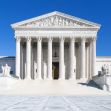On April 20, 2020, the Supreme Court deemed it unconstitutional to convict a criminal in state court without a unanimous jury in its ruling on Ramos v. Louisiana. According to the decision, the Sixth Amendment of the Bill of Rights requires trial “by an impartial jury.” Therefore, it necessitates a unanimous jury verdict on both federal and state-level criminal trials.
This unanimity component of the Sixth Amendment traces back to England, with the idea that jury verdicts must be “confirmed by the unanimous suffrage of twelve of his equals and neighbors indifferently chosen and superior to all suspicion.” The Court recognized in a 1930 decision, Patton v. United States, that trial by jury inherently involves all the “essential elements as they were recognized in this country and England when the Constitution was adopted,” requiring that a jury of exactly 12 operate under a judge to reach a unanimous verdict. The report goes on to say that these elements of the jury are “not open to question,” and that any attempt to alter the details of a jury trial is “vain and ineffectual, whatever form it may take.” It was written into the U.S. Constitution as such, and in the original 13 state constitutions and all that followed.
The Constitution’s Bill of Rights was initially only applied to the U.S. federal government. However, based on the 14th Amendment’s guarantee against denying “life, liberty, or property, without due process of law,” Supreme Court rulings over the years have applied the first ten amendments to the state governments as well. This process is known as “incorporation,” and it has successfully integrated the Bill of Rights, almost in its entirety, to each state’s constitution.
The Sixth Amendment alone dodged incorporation up until this point, despite the incidental fact that the states wrote such laws into their own constitutions anyway. At least, this was the case until a couple of states made some of their own adverse amendments to that standard.
The only two states that (until recently) maintained state laws allowing non-unanimous verdicts were Oregon and Louisiana. The adoption of the modification has a torrid history. In Oregon, the change was made after a single juror voted against the conviction of a Jewish man accused of killing a Christian in the early 1900s. For Louisiana, it was a response to a Supreme Court decision that black people could not be excluded from juries. In both states, the laws are understood to be distinctly racially motivated.
Louisiana recently repealed its law to this effect, but it did not apply retroactively to the Ramos v. Louisiana case concerning a murder committed in 2014. The defendant, Evangelisto Ramos, was sentenced to life in prison and hard labor by 10 out of the 12 jurors. Ramos has since maintained his profession of innocence and argued against the conviction on account of his Sixth Amendment rights. In the 6-3 majority opinion, authored by Justice Neil Gorsuch, the Court found this logic to be sound, thereby incorporating perhaps the last component of the Bill of Rights to extend to state governments.
Now, this ruling isn’t going to shatter court systems and change the concept of a jury trial. Rather, it applies the most orthodox sense of a jury uniformly. But although the decision’s literal adoption won’t necessarily break down systems of injustice, it does condemn the history of racially motivated law. Furthermore, the Ramos decision confirms that the freedoms afforded in the Bill of Rights can not be curtailed by any means throughout the governing bodies of the United States. The federal government has, in essence, asserted a quiet but steady power to disavow deviations from the birthrights indemnified by our Founders.






